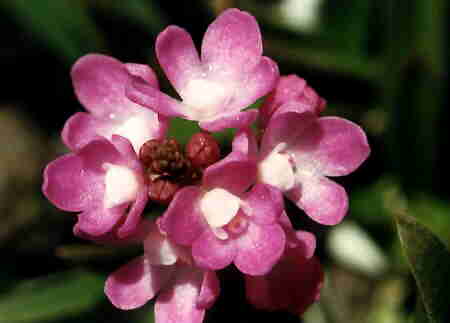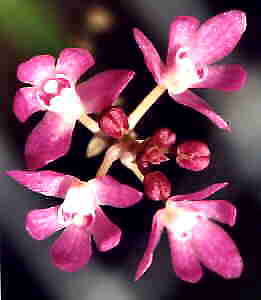Sarcochilus cecileae and
Sarcochilus roseus in the wild
Pink Bells

Pinned in my memory was old Stan's description,"Pink Bells"; he claimed you could see them in flower from the road if you looked carefully. I never did, from the road, but close up, along the fault in the rock face, they were certainly there, little clumps of Sarcochilus cecileae, in flower, glittering pink, their faces upturned as though to catch the sun. And another vague image, heard second hand, a road worker's "Look what I found"; in his hands old Stan's "Pink Bells", torn fom the rock crevice, pillaged, destroyed, a curiosity.
Sarcochilus plants in the wild
But I was now 100 miles and 30 years from old Stan's cherished colony of Sarcochilus cecileae, in a different place far from human activity, half way up the ravine. The slope was steep, and daunting to a not so brave climber, eyes fixed on the top of the waterfall.
The waterfall was gleaming white and sounded like the chatter of a crowded room. I climbed the steep wall, carefully. This was my second visit, I had returned to see in flower and photograph plants of Sarcochilus cecileae and what I thought could be Sarcochilus roseus. The creek above the falls had rocky outcrops along one bank, canopied rain forest along the other.
On the rocky outcrops, in crevices and crannies, small plants and clumps of Sarcochilus cecileae grew, in the exposed sunlit areas, their leaves reddish from the sun. They clung to crevices, their roots into the cracks and into small tussocks of grass, almost terrestrial.
Under the forest canopy, on the opposite side, this species also grew on top of boulders, out of reach of flooding creek water, their leaves plump and green, but still showing evidence of flower spikes. Within a few metres, on the edges of the rock outcrops, where the thin grass managed to grow out of reach of both fire and flood, were plants of a Sarcochilus with a climbing, elongated appearence.
Sarchochilus roseus
The plants appeared to be growing in the grass, but close examination showed that they were in fact growing in the rock and rubble, and threading their way up through the grass to the sunlight. Sarcochilus roseus? I had returned to photograph and learn its identity, to put a name to countless baby seedlings in bottles, a seedpod found on the first visit.
 The rocky outcrops were steep, and on one broad outcrop, there grew on one side numerous plants of Dendrobium speciosum. On the other side of the rock, as though seperated by a wide flat wall, were numerous plants of Dendrobium ruppiosum, a natural hybrid between Dendrobium speciosum and Dendrobium ruppianum. Strangely seperated, each colony occupied its own territory. In the tree tops along the creek, we observed a few plants of Dendrobium ruppianum, outnumbered by its hybrid children growing in the leaves and rubble in the rock crevices. The rocky outcrops were steep, and on one broad outcrop, there grew on one side numerous plants of Dendrobium speciosum. On the other side of the rock, as though seperated by a wide flat wall, were numerous plants of Dendrobium ruppiosum, a natural hybrid between Dendrobium speciosum and Dendrobium ruppianum. Strangely seperated, each colony occupied its own territory. In the tree tops along the creek, we observed a few plants of Dendrobium ruppianum, outnumbered by its hybrid children growing in the leaves and rubble in the rock crevices.
And the flowers I had come to photograph? Both colonies of Sarcochilus were in fact all the same species, with varying growth habits due to their growing position. Those in the full sunlight were stunted, while those in the grass and shade were forced to elongate in their quest for sunlight. The bright pink purple to rose coloured flowers were those of the form of Sarcochilus cecileae variously called var roseus or Sarcochilus roseus. So I found a name for the bottle babys, and a different form to old Stan's "Pink Bells", the original type form.
|


 The rocky outcrops were steep, and on one broad outcrop, there grew on one side numerous plants of Dendrobium speciosum. On the other side of the rock, as though seperated by a wide flat wall, were numerous plants of Dendrobium ruppiosum, a natural hybrid between Dendrobium speciosum and Dendrobium ruppianum. Strangely seperated, each colony occupied its own territory. In the tree tops along the creek, we observed a few plants of Dendrobium ruppianum, outnumbered by its hybrid children growing in the leaves and rubble in the rock crevices.
The rocky outcrops were steep, and on one broad outcrop, there grew on one side numerous plants of Dendrobium speciosum. On the other side of the rock, as though seperated by a wide flat wall, were numerous plants of Dendrobium ruppiosum, a natural hybrid between Dendrobium speciosum and Dendrobium ruppianum. Strangely seperated, each colony occupied its own territory. In the tree tops along the creek, we observed a few plants of Dendrobium ruppianum, outnumbered by its hybrid children growing in the leaves and rubble in the rock crevices.